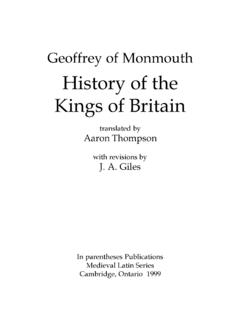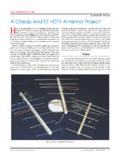Transcription of NUMBERS IN GREAT b BRITAIN - Metadyne
1 Copyright - not to be printed 1 A HISTORY OF MOTOR CAR REGISTRATION NUMBERS IN GREAT BRITAIN BY M. A. C. HORNE Copyright - not to be printedVehicle registrations Draft 4 20/12/03 2 W:\WRITINGS\Other publications in hand\Car Registrations\Car Registration NUMBERS MOTOR VEHICLE REGISTRATION AND LICENSING IN BRITAIN UNTIL THE 1980S INTRODUCTION Observation of a sufficient number of modern British vehicle registration plates will suggest a loose association between some of the letters contained in the registration number and the locality in which they are being observed. This is no accident, and is the result of a process of vehicle registration going back almost to the turn of the century. ORIGINS Towards the end of the nineteenth century the normal means of conveyance by road was by horse or horse-drawn vehicle.
2 Mechanically propelled vehicles, mainly using steam power, were in mounting evidence but these were principally locomotives (traction engine type vehicles) used for towing trailers or for powering equipment. They were heavy, slow, damaged the roads and were alleged to frighten horses. This unpopularity contributed to the legislation which confined their maximum speed to 4 MPH and required three persons to be in attendance, one of whom had to precede the vehicle and clear the way. Locomotives were certainly not passenger-carrying vehicles, but as practical motor cars began to emerge the locomotive legislation was found to apply, and this adversely impacted on the emerging motoring fraternity. Although motor cars existed for a while during the last years of the nineteenth century they were not practical vehicles to drive until the immense restrictions of the so called red flag Act were removed by the Locomotives Act of 1896.
3 This created a new class of vehicle called a Light Locomotive, and these were permitted to travel at up to 14 MPH provided they weighed under two tons, as most cars would have done. For around six years the development of motor cars proceeded apace. However three principle objections emerged. First, heavier vehicles were demanded. Secondly, it was felt that the speed limit was unnecessarily restrictive, and thirdly there was growing evidence of dangerous or furious driving which was difficult to deal with without an effective means of tracing vehicles or their owners (suggesting widespread failure to stop at the scene of any accident, and other elements of irresponsibility). The result was the Motor Car Act 1903, which introduced the expression motor car (instead of light locomotive), increased the speed limit to 20 MPH and introduced a variety of other measures.
4 For example, in order to clamp down on reckless driving, and detect more readily those infringing the law, the licensing of drivers began (though without tests) together with the application to vehicles of clearly displayed identification marks. Section 2 of the 1903 Act required that: every motor car be registered with a County or County Borough Council; every such Council would issue a separate number to every motor car registered with them; Copyright - not to be printedVehicle registrations Draft 4 20/12/03 3 W:\WRITINGS\Other publications in hand\Car Registrations\Car Registration NUMBERS each motor car would be obliged to display a mark indicating the registered number and the Council with which registered. Details of the new scheme as applied in England & Wales were set out by the Local Government Board in the form of regulations1.
5 These stated that: each Council would be allocated a distinguishing mark consisting of one or two letters, as set out in the table appended to the Order; each Council would maintain a register in which details of every motor car registered with them would be kept; each Council would assign an individual Registration number to each car or motor cycle so registered with them, on payment of a twenty shilling fee; each motor car would be obliged to display two plates or designs (one to the front and one to the rear) which conformed to a definite specification set out in the order, which included that the plates should be rectangular with 3 inch lettering in white on black ground; comparable, but slightly different requirements, were imposed on motor cycles; arrangements were made to adjust the registration entry in the event of a material change to the vehicle or change of owner, though in the latter case the option of cancelling the registration (for re-registration of the vehicle elsewhere) was an option; the Council, if it saw fit, could supply any plates required.
6 Arrangements were made for the use of manufacturers or dealers plates, which were issued to dealers by the appropriate Councils for use on vehicles as required; dealers had to keep detailed records of their use, and the plates were to be similar to normal plates but had to be a different colour. Supplementary guidance issued by the Local Government Board stated that regulations comparable to the above were also being issued for Scotland and Ireland (which, of course, have different legal systems) to form something fairly uniform across the British Isles2. In particular the guidance notes relating to the English order indicated that the Local Government Board had agreed not to use the registration letters G, I, S, V or Z, either singly or in combination (G, S and V were to be used in Scotland, and I and Z in Ireland).
7 The guidance added clarity in two particular areas. Firstly it noted that the term Motor Cycle was not defined and suggested that it might credibly be applied to motor cars with not more than three wheels and weighing less than three hundredweight. Secondly it noted that the use of manufacturers plates on otherwise unregistered 1 The Motor Car (Registration & Licensing) Order, 1903 [SR&O 1903 No. 998], dated 19th November 1903. 2 The orders in those countries were the Motor Car (Registration & Licensing) (Scotland) Order, 1903 [SR&O 1903 No. ???], and the Motor Car (Registration & Licensing) (Ireland) Order [SR&O 1903 No. ???]. Copyright - not to be printedVehicle registrations Draft 4 20/12/03 4 W:\WRITINGS\Other publications in hand\Car Registrations\Car Registration NUMBERS vehicles were required to be a different colour from normal, and it was suggested that white lettering on a red ground would make the plates readily distinguishable.
8 The guidance was vague in other areas. The Board, it was said, contemplated that councils would usually assign consecutive NUMBERS to cars registered with them. But they thought that for purposes of ready distinction not more than three figures should be assigned (the regulations themselves did not actually refer to any upper limit). They would consequently be prepared, if desired, to assign a fresh index mark to any council who may require to start a fresh series of NUMBERS under a new mark. This, of course, significantly affected the way things were to develop in the future. The new Act was to come into force on 1st January 1904, when the following situation pertained. In England the various licensing authorities were listed in descending order of population and index marks were issued to each of them, in the range A-Y (London-Somerset) and AA-FP (Hampshire-Rutland), in that order, but omitting (as mentioned earlier) the letters G, I, S, V and Z (nor was Q used, probably to avoid confusion with O).
9 The majority of councils started to issue registration NUMBERS , starting at 1, from December 1903 or January 1904 (note that although A1 is the lowest letter/ number combination and emanated from London it was not the earliest registration number issued) In contrast, Ireland issued registration marks in alphabetical order of county licensing authority in the series IA-IZ (Antrim-Mayo) and AI-NI (Meath-Wicklow). In addition the marks OI-WI (Belfast-Waterford) were allocated to the County Borough Councils. The letters G, Q, S and V were nevertheless avoided, as was the single use of the letter I or its combination II . Letter combinations using Z were not issued at this stage, other than as part of an I series. Scotland, like Ireland, also issued marks in alphabetical order of licensing authority, counties first, with the majority of the series falling in the range SA-SY (Aberdeenshire-Midlothian) and AS-PS (Nairn-Zetland).
10 RS-XS (Aberdeen-Paisley) were issued to Burgh authorities in alphabetical sequence. The letters I, Q and Z were avoided and there were initially many gaps (for example SC, SF, SG, CS, FS). The single letter codes G (Glasgow), S (Edinburgh), and V (Lanarkshire) were also issued. There were no double letter combinations using G or V (except for SV/VS which were really combinations in the S series). Curiously the mark BF (Dorset) was withdrawn towards the end of 1904, and an order of the Local Government Board (dated 27th December 1904) allocated Dorset the mark FX instead. It has been suggested that the letters BF had ungentlemanly connotations, but it is not known what happened to the registration NUMBERS already issued (if any). A little while later a similar thing happened with the DF mark for Northampton County Borough, which was issued the mark NH instead.







